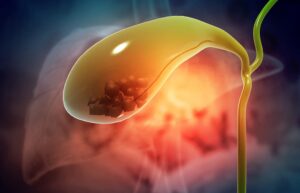What Does the Gallbladder Do (Besides Make Stones)?

The gallbladder may be the least understood of all your body parts, but it sure knows how to make itself known.
Exhibit A: Those galling stones.
This painful ailment, which is diagnosed in nearly 1 million Americans a year, typically serves as the introduction to the otherwise unassuming organ. Our stomachs grumble and our hearts race, our bladders get full and our urethras regularly empty them out. But the tiny gallbladder (all 4 inches of it) goes about its daily business pretty quietly.
Unless an imbalance occurs.
“Hello, there” with a capital OUCH!
That imbalance – of the substances inside the gallbladder – can lead to the development of gallstones, or common duct stones. You might think duct stones are an “I’ll worry about it when I need to” condition, but why not be prepared? Especially now, because February is Gallbladder and Bile Duct Cancer Awareness Month.
The following quiz is set up to explain the gallbladder’s role in your body and the serious health issues gallstones might signal. Try it. If you already know all about the gallbladder, pass this quiz on to someone you care about.
Question: Where is the gallbladder?
Answer: This small, pear-shaped organ is located on the upper right side of your abdomen, under the liver and above the small intestine. It is connected to each of these other body parts through ducts, or small channels.
Q: What does the gallbladder do?
A: The gallbladder’s No. 1 job is to store extra bile (digestive agents) produced by the liver. Bile – composed of fluids, fats, and cholesterol – helps the body break down the fats we eat so their nutrients can more easily be absorbed in the blood stream. The liver passes bile to the gallbladder through one of the ducts. The gallbladder then releases its bile reserves into the small intestine whenever we eat foods that contain fats that require digestion.
Q: Can my gallbladder get sick?
A: Yes. Common gallbladder ailments include inflammation, bile duct infections, and stones. Gallstones, which affect nearly 25 million people total, develop when substances in the bile crystalize into small pebbles that can block the ducts. People with a history of gallbladder and/or bile duct stones have a slightly higher risk of developing gallbladder and bile duct cancer.
Q: Who is at risk of developing stones?
A: Lifestyle factors that increase the risk of stones include obesity, low-fiber diets that are high in fats and cholesterol, and lack of exercise. Non-lifestyle factors include family history, having diabetes and/or liver disease, and age (older than 40). Stones also are more common among women and people of Native American, Hispanic, or Mexican origin.
Q: How do you recognize gallstones?
A: Because gallstones can be as tiny as a grain of sand, some hang around for years without their person ever knowing. But in time, they can trigger serious health issues including inflammation and infection.
For example, as stones grow (some can reach the size of a ping pong ball), they become a greater risk of blocking the ducts that lead in and out of the gallbladder. The most common symptoms of bile duct stones include:
- Upper abdominal pain (often after eating)
- Dark urine
- Nausea and vomiting
- Gas or indigestion
Q: Can they be treated?
A: You bet. About 25% of people diagnosed with gallstones annually need treatment. If the stones cause severe symptoms, physicians typically recommend gallbladder removal (cholecystectomy). But don’t panic, the body can still digest food; the bile from the liver will be directed to the small intestine.
Among the common procedures:
Laparoscopic cholecystectomy – A fiber-optic instrument (with a lighted camera) is inserted through a small incision in the abdomen, enabling the surgeon to see and then remove the gallbladder through another incision.
Open cholecystectomy – If the gallbladder is severely inflamed and cannot safely be removed through small cuts, it will be taken out through larger incisions, usually 6 inches.
Endoscopic retrograde cholangiopancreatography (ERCP) – If stones are blocking the ducts, they may need to be removed before gallbladder surgery. This procedure combines an upper endoscopy – feeding a camera-equipped tube through the esophagus and into the stomach – with X-rays to find and remove stones.
Q: What should someone who experiences gallstone symptoms do?
A: Make an appointment to see a gastroenterologist and drink lots of water in the meantime. In advance of the appointment, you may find it helpful to jot down a list of symptoms, lifestyle changes, and any medications you are taking.
When it Comes to Your Health, There are No Bad Questions
Regardless of how you scored on our Gallbladder Awareness quiz, you may find you still have unanswered questions. We welcome them. Plenty of our patients come with queries, such as whether other health conditions might complicate gallbladder treatment. These questions can help keep you focused, and make the most of the appointment time.
If you’re interested in learning more about the gallbladder and common bile duct stones, click here.
